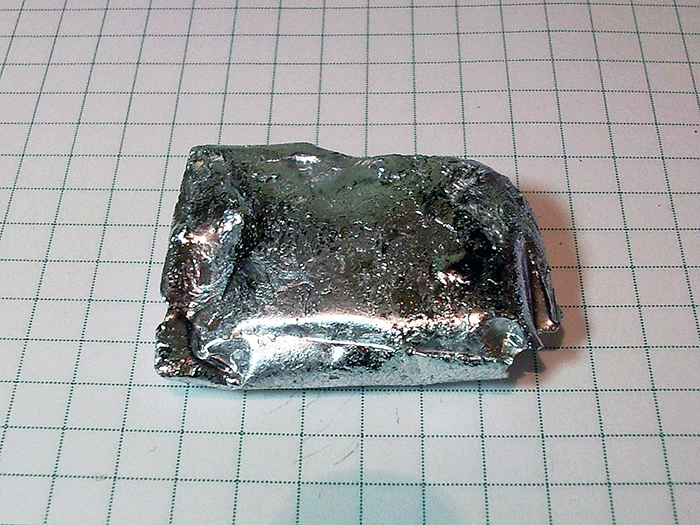Gallium Ingot 99,999%

Gallium Ingot As gallium already liquefies at room temperature, it is difficult to form gallium ingots that stay in shape.
Just four years after Dmitri Mendeleev published his periodic table published in 1871, predicted the element 31 and gave it the provisional name eka-aluminum, spectroscopic evidence of the presence of the element was provided in a sphalerite sample by Paul Emile Lecoq de Boisbaudran. Lecoq later discovered other elements, but named gallium, his first, from Latin for Gaul, the area occupied by his French homeland. For the next eighty-five years it was primarily a curiosity - a metal that is solid at room temperature but liquefies in the hand - but which is used in the manufacture of metal alloys with special properties such as: B. Low temperatures found use - melting points in high temperature thermometers and as a reflective compound in mirrors.
The use of gallium changed forever in the 1960 years, when gallium arsenide was developed as a semiconductor with slightly different electrical properties than the more common silicon, and that is better suited than silicon for some applications. In particular, gallium arsenide is a direct bandgap semiconductor, which means that it can both absorb and emit light with high efficiency. It offered to use gallium in LEDs and lasers. In addition, extremely thin layers of gallium arsenide can effectively absorb all the photons of the incoming sunlight, as opposed to the thick layers of silicon required for the same task. This enables generation of one type of thin film solar cell. Gallium arsenide semiconductor devices also have lower noise than those made of silicon, and are therefore preferred in many telecommunications applications.
In addition to being a component of gallium arsenide, gallium can be used to make several other semiconducting compounds. The gallium semiconductors are used in many applications including light emitting devices such as LEDs and lasers, photovoltaic and thermophotovoltaic cells, and integrated circuits. Gallium is also used in some highly specialized engineering applications, including in neutrino detection telescopes, which are characterized by their high gallium demand - the gallium-germanium neutrino telescope used in the SAGE experiment at the Baksan neutrino observatory in Russia at least 55 tons of the molten metal. It can also serve as a liquid metal ion source for focused ion devices. Gadolinium gallium garnets are used to manufacture optical components and as a carrier material for magneto-optical films and high-temperature superconductors. Finally, gallium phosphate is a piezoelectric material that, unlike alternatives like quartz, can function at high temperatures, making it useful for pressure and force sensors in high temperature applications.
Gallium is by nature not a compound that plays a role in human biology. However, since it is generally considered non-toxic at low doses and mimics some of the properties of iron in the body, it is useful in some medical applications. Gallium tends to concentrate in areas of high inflammatory and cell growth. Therefore, radioactive isotopes of the element are used in scans to track the spread of some cancers and disorders of the immune system. In addition, gallium salts are used to treat hypercalcaemia, which is caused by cancer that metastasizes to the bones, and is being used to treat certain cancers. It is also known that gallium compounds are toxic to some disease-causing microorganisms, and organometallic gallium compounds have shown promise as potential malaria treatment agents.
The few minerals that contain a significant amount of gallium are too rare to serve as a commercially available source of the element. Gallium is present in small quantities in the aluminum ore bauxite and in the zinc ore sphalerite and is therefore obtained from wastes generated during the processing of these metals.
Metallic gallium bars with the highest possible quality and density. Ingots are generally the least expensive metal form and are suitable for general applications. Standard billet size is nominal 2-3 cm x 3-8 cm x 6-12 cm. Materials are made using crystallization, solid state, and other ultrahigh-cleaning methods such as sublimation. Gallium is also produced as a piece, ingot, pellet, sample and in composite forms, such as oxide.
